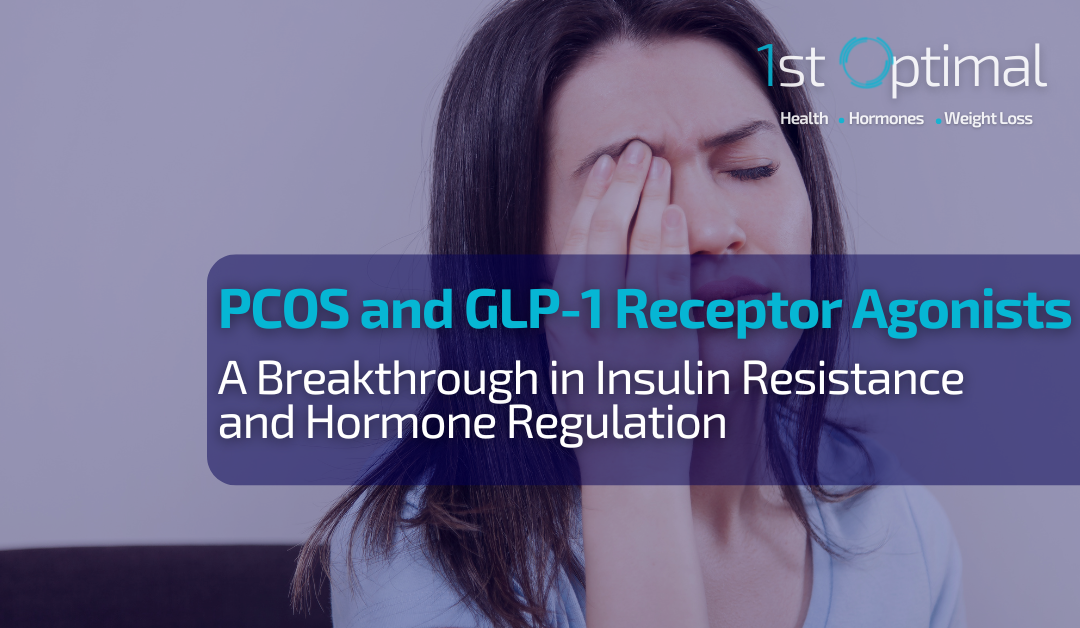For many high-performing women, a PCOS diagnosis can feel like a significant roadblock. The condition’s impact on energy, focus, and body composition can interfere with both personal and professional goals. While traditional treatments like Metformin have been a starting point for years, they don’t work for everyone and often fall short in delivering comprehensive results. A newer class of medications, GLP-1 receptor agonists, offers a more targeted approach by directly addressing the insulin resistance at the heart of the condition. This guide breaks down the science behind GLP1 and PCOS, explaining how these treatments work to regulate hormones, support weight loss, and restore metabolic balance for lasting results.
PCOS and Insulin Resistance: What’s the Connection?
Polycystic Ovary Syndrome (PCOS) is one of the most common endocrine disorders, affecting up to 15% of women of reproductive age. It is characterized by a combination of symptoms such as irregular menstrual cycles, excessive androgen levels, and the presence of polycystic ovaries. A key underlying feature of PCOS is insulin resistance, which exacerbates the hormonal imbalances and metabolic complications seen in this condition.
The Scope of PCOS and Its Metabolic Impact
PCOS is far more than a reproductive issue; it’s one of the most significant metabolic conditions affecting women today. As the most common hormone problem for women of childbearing age, studies show it affects anywhere from 6% to 20% of this group. While irregular periods and high androgen levels are the classic signs, the metabolic fallout is where the long-term health risks really lie. At least half of all women with PCOS are obese, and a staggering 50% to 80% struggle with insulin resistance, which is a major driver of the condition’s hormonal chaos and a precursor to type 2 diabetes.
These metabolic complications can seriously compromise long-term health, yet many conventional treatments only manage symptoms instead of addressing the root metabolic dysfunction. This is why simply being told to “lose weight” can feel frustrating and ineffective when your body’s hormonal and metabolic systems are working against you. Understanding the deep metabolic impact of PCOS is the first step toward finding a strategy that targets the underlying issues, helping you regain control over your energy, weight, and overall well-being.
How Insulin Resistance Drives PCOS Symptoms
Insulin resistance occurs when the body’s cells fail to respond effectively to insulin, leading to higher circulating insulin levels (hyperinsulinemia). This is significant in PCOS for several reasons:
- Androgen Overproduction: Elevated insulin levels stimulate the ovaries to produce excess androgens, like testosterone.
- Ovulatory Dysfunction: Insulin resistance disrupts follicle development and ovulation, causing irregular menstrual cycles.
- Metabolic Complications: Women with PCOS are at increased risk for type 2 diabetes, obesity, and cardiovascular disease due to insulin resistance.
Decoding the Hormonal Imbalance of PCOS
The interaction between insulin and the hypothalamic-pituitary-gonadal (HPG) axis further complicates PCOS. Disruptions in the luteinizing hormone (LH) and follicle-stimulating hormone (FSH) balance, coupled with elevated androgens, lead to anovulation and infertility.
A Look at Traditional PCOS Treatments
Traditional treatments for PCOS include lifestyle modifications, insulin-sensitizing agents like metformin, and hormonal therapies. However, these interventions are not always effective for all patients, paving the way for innovative treatments like GLP-1 receptor agonists.
Better Insulin Sensitivity, Better Hormones: How They’re Linked
Insulin’s Role in Hormone Regulation Insulin is not just a metabolic hormone; it plays a crucial role in reproductive health. It influences the HPG axis by modulating the secretion of LH and FSH. Elevated insulin levels in PCOS lead to:
- Increased Androgens: Hyperinsulinemia directly stimulates the ovarian theca cells to overproduce testosterone.
- Impaired Ovulation: High insulin levels inhibit follicular maturation, causing anovulation.
Could GLP-1 Agonists Be the Answer for Insulin Resistance?
GLP-1 receptor agonists (GLP-1RAs) are a class of medications initially developed for managing type 2 diabetes. These drugs mimic the action of glucagon-like peptide-1, a hormone that enhances insulin secretion, reduces glucagon levels, and slows gastric emptying.
So, How Do GLP-1s Actually Work?
GLP-1RAs improve insulin sensitivity through several pathways:
- Reduction in Blood Glucose Levels: By enhancing insulin secretion in response to meals.
- Weight Loss: These medications promote satiety, leading to significant reductions in body weight.
- Hormonal Regulation: Emerging evidence suggests that GLP-1RAs directly influence the HPG axis and ovarian function.
Commonly Prescribed GLP-1 Medications
Some commonly prescribed GLP-1RAs include:
| Generic Name | Brand Name(s) | Administration | Approval Year | Manufacturer |
| Exenatide | Byetta, Bydureon | Injection | 2005/2012 | AstraZeneca |
| Liraglutide | Victoza, Saxenda | Injection | 2010 | Novo Nordisk |
| Albiglutide | Tanzeum | Injection | 2014 | GSK |
| Dulaglutide | Trulicity | Injection | 2014 | Eli Lilly |
| Lixisenatide | Lyxumia (EU), Adlyxin (US) | Injection | 2016 | Sanofi |
| Semaglutide | Ozempic, Rybelsus, Wegovy | Injection, Oral | 2017 | Novo Nordisk |
| Tirzepatide | Mounjaro, Zepbound | Injection | 2022 | Eli Lilly |
The Science-Backed Benefits of GLP-1 for PCOS
- Insulin Sensitivity: GLP-1RAs significantly reduce insulin resistance, helping to alleviate hyperinsulinemia.
2. Androgen Levels: These medications lower testosterone levels, reducing symptoms like hirsutism and acne.
3. Menstrual Regularity: Improved insulin sensitivity and weight loss contribute to more regular ovulatory cycles.
Improvements in Overall Quality of Life
The benefits of addressing insulin resistance with GLP-1s go far beyond lab results. For women with PCOS, these changes can dramatically improve day-to-day life. Research highlights that the weight loss associated with GLP-1s often leads to better social, physical, and mental well-being. Restoring menstrual regularity can also bring a profound sense of relief and predictability, which is invaluable. This isn’t just about managing a condition; it’s about reclaiming your vitality. The psychological benefits, including enhanced self-esteem and reduced anxiety, are just as important as the physical ones. A comprehensive treatment plan recognizes that feeling your best is the ultimate goal, allowing you to perform at your peak in all areas of life.
Why GLP-1s Can Help with Weight Loss in PCOS
Weight loss is a cornerstone of PCOS management, as even modest reductions in body weight can significantly improve insulin sensitivity, restore ovulation, and reduce hyperandrogenism. GLP-1 receptor agonists are particularly effective in promoting weight loss, making them a valuable therapeutic option for women with PCOS.
The “How” Behind GLP-1-Driven Weight Loss
GLP-1 receptor agonists facilitate weight reduction through the following pathways:
- Appetite Suppression: GLP-1 enhances satiety by acting on the central nervous system, particularly the hypothalamus, reducing calorie intake.
- Delayed Gastric Emptying: Slower digestion results in prolonged feelings of fullness after meals.
- Increased Energy Expenditure: Some studies suggest that GLP-1 agonists may modestly increase metabolic rate.
Measurable Results: What the Data Shows on Weight and Body Composition
The data on GLP-1s for women with PCOS is compelling, showing concrete improvements in body composition. For instance, a major meta-analysis found these medications helped women with PCOS reduce their waist size by an average of two inches and lower their Body Mass Index (BMI) by nearly 2.5 points. Other research shows that women can achieve a significant body weight reduction of over 5%. While these numbers are impressive on their own, their real power lies in what they mean for your overall health. This degree of weight loss is often enough to improve insulin sensitivity, help restore ovulation, and lower androgen levels—addressing the core metabolic issues that drive PCOS symptoms.
How Losing Weight Can Improve PCOS Symptoms
- Improved Ovulation Rates: Weight loss can reverse anovulation by reducing the effects of insulin resistance on ovarian follicles.
- Reduction in Androgen Levels: Lower body weight correlates with decreased testosterone production, alleviating symptoms like hirsutism and acne.
- Enhanced Pregnancy Outcomes: Weight loss improves fertility and reduces the risk of complications during pregnancy.
GLP-1 Agonists vs. Metformin: Which Is Right for PCOS?
Metformin has long been a mainstay of PCOS treatment due to its ability to enhance insulin sensitivity and reduce circulating insulin levels. However, emerging evidence suggests that GLP-1 receptor agonists may offer distinct advantages.
Breaking Down the Key Differences
| Aspect | Metformin | GLP-1 Agonists |
| Primary Action | Reduces glucose production in the liver | Enhances insulin secretion and reduces appetite |
| Weight Loss | Modest impact | Significant weight reduction |
| Hormonal Effects | Limited impact on androgen levels | Reduces androgens and improves menstrual cycles |
| Tolerability | Common gastrointestinal side effects | Some nausea, but generally well tolerated |
When GLP-1s Are a Good Alternative
So, when does it make sense to consider a GLP-1 agonist? While Metformin is a solid starting point for many, GLP-1s shine in a few key situations. If significant weight loss is a primary goal, these medications can be particularly effective. The resulting weight reduction often leads to a positive cascade of effects, including better insulin sensitivity and more regular menstrual cycles. Furthermore, GLP-1s are a strong alternative for women with PCOS who can’t tolerate Metformin, often due to its gastrointestinal side effects. They also directly address the hormonal side of PCOS by helping to lower androgen levels, which can reduce frustrating symptoms like acne and unwanted hair growth. The right choice ultimately depends on your unique physiology and health goals, which is why a personalized, data-driven approach is essential for creating a treatment plan that truly works for you.
Can You Use GLP-1s and Metformin Together?
The combination of metformin and GLP-1 receptor agonists has shown promise in managing PCOS, leveraging the complementary effects of both medications.
GLP-1s and Fertility: What We Know About Pregnancy and PCOS
One of the most promising applications of GLP-1 receptor agonists is their potential to improve fertility outcomes in women with PCOS. Recent studies highlight their role in enhancing natural pregnancy rates and supporting reproductive health.
Improving Ovulation and Egg Quality
- Restoration of Ovulation: By improving insulin sensitivity and reducing androgens, GLP-1 receptor agonists promote regular ovulatory cycles.
- Enhanced Egg Quality: Lower insulin levels and reduced oxidative stress may improve the quality of oocytes, increasing the likelihood of successful fertilization.
Enhancing Fertility Treatment Outcomes
For women with PCOS who are trying to conceive, GLP-1 agonists are emerging as a powerful tool to support fertility outcomes. These medications go beyond weight loss to address the root hormonal issues that can make pregnancy challenging. By improving insulin sensitivity, GLP-1s help restore regular ovulatory cycles—often the first and most significant hurdle. There is also growing evidence that by lowering insulin levels and reducing related cellular stress, these treatments can improve egg quality, increasing the likelihood of successful fertilization. When combined with more predictable menstrual cycles, these factors create a much more favorable environment for conception, making GLP-1s a promising part of a comprehensive, medically guided fertility plan.
A Note on Safety During Pregnancy
Although GLP-1 receptor agonists are not recommended for use during pregnancy due to limited safety data, their pre-pregnancy use can help optimize metabolic and hormonal health, setting the stage for better pregnancy outcomes.
The Importance of a “Washout Period” Before Conception
If you’re using a GLP-1 medication and planning to conceive, one of the most critical steps is a “washout period.” This means stopping the medication for a specific time before you start trying. The reason is simple: current guidelines advise against using these medications during pregnancy due to limited safety data. A washout period ensures the drug is completely out of your system, allowing your body to return to its natural hormonal baseline. Think of it as the final phase of preparation. The work you’ve done to improve your metabolic health has already created a better foundation for conception; this pause is the transition from active treatment to actively trying. A medical provider can create a personalized timeline based on your specific medication, helping you move forward with confidence.
How GLP-1 Agonists Help Regulate Your Hormones
GLP-1 receptor agonists exert profound effects on hormonal regulation through their interactions with the hypothalamic-pituitary-gonadal (HPG) axis and metabolic pathways.
The Impact on Your Brain-Ovary Connection (HPG Axis)
- Luteinizing Hormone (LH) Regulation: Elevated LH levels, a hallmark of PCOS, are reduced with improved insulin sensitivity, restoring hormonal balance.
- Follicle-Stimulating Hormone (FSH): GLP-1 receptor agonists may indirectly support FSH-driven follicle maturation by normalizing insulin levels.
Balancing Estrogen and Progesterone Levels
- Estrogen Regulation: Lower insulin levels reduce ovarian androgen production, allowing for more balanced estrogen levels.
- Progesterone Production: Enhanced ovulation improves the luteal phase, leading to adequate progesterone secretion.
Lowering High Androgens (Hyperandrogenism) with GLP-1s
Hyperandrogenism, or excess androgen levels, is a primary driver of many PCOS symptoms, including acne, hirsutism, and alopecia. GLP-1 receptor agonists have demonstrated significant potential in mitigating this condition.
How Do They Lower Androgen Levels?
- Direct Ovarian Effects: GLP-1 agonists may modulate ovarian steroidogenesis, reducing androgen output.
- Improved Insulin Sensitivity: By lowering insulin levels, these medications indirectly suppress androgen production.
- Weight Loss-Independent Effects: Evidence suggests that GLP-1 receptor agonists can reduce androgens even in the absence of significant weight loss.
What the Clinical Studies Show
A systematic review of GLP-1 receptor agonists highlighted significant reductions in testosterone levels in women with PCOS, accompanied by improvements in skin health and hair growth patterns.
What Are the Downsides? Challenges of GLP-1 Agonists
Despite their promising benefits, GLP-1 receptor agonists are not without limitations.
Considering the Cost and Accessibility
The high cost of GLP-1 medications can be a barrier for many patients, particularly in regions where insurance coverage is limited.
Potential Side Effects to Be Aware Of
While generally well-tolerated, GLP-1 receptor agonists can cause mild to moderate side effects, such as:
- Nausea
- Vomiting
- Diarrhea
- Rarely, pancreatitis or gallbladder issues
Managing Common Side Effects
It’s true that the initial adjustment period for GLP-1 medications can come with some gastrointestinal discomfort. The good news is that for most people, side effects like nausea are temporary and manageable. The most effective strategy is to start with a low dose and increase it gradually, giving your body time to adapt. You can also minimize symptoms by eating smaller meals, avoiding high-fat foods, and staying hydrated. Most importantly, communicating any reactions to your healthcare provider is essential. A dedicated medical team can adjust your dosage and provide personalized guidance to make your treatment both effective and comfortable. This continuous support is crucial for navigating the initial phase and ensuring you can achieve your health goals with minimal disruption.
Why We Need More Long-Term Research
Although the short-term benefits of GLP-1 receptor agonists are well-documented, long-term studies are needed to fully understand their impact on PCOS management and overall health.
Is a GLP-1 Agonist Right for Your PCOS?
When considering GLP-1 receptor agonists for PCOS treatment, it is essential to adopt a patient-centered approach.
Who Is a Good Candidate for GLP-1s?
- Failure of traditional therapies like metformin
- Coexisting obesity or type 2 diabetes
- Severe hyperandrogenism or menstrual irregularities
Essential Pre-Treatment Screening
Before starting any new treatment, a thorough medical screening is non-negotiable. This isn’t just about checking boxes; it’s about creating a safe and effective plan tailored specifically to you. Your provider will need to carefully review your health history for any contraindications, such as a personal or family history of pancreatitis or specific thyroid cancers. A comprehensive metabolic workup is also essential to assess for metabolic syndrome, which includes checking your blood pressure, cholesterol levels, and glucose tolerance. For some women, particularly those with a BMI of 27 or higher, an oral glucose tolerance test (OGTT) may be used to get a precise understanding of how your body handles sugar. This detailed, data-driven approach ensures that GLP-1 therapy is the right fit for your unique physiology.
Getting the Dosage and Monitoring Right
Regular monitoring of blood glucose, weight, and hormonal parameters is crucial. Dosages should be titrated to minimize side effects while maximizing benefits.
Why a Team Approach to Care Matters
A comprehensive treatment plan should involve:
- A reproductive endocrinologist
- A nutritionist or dietitian
- A mental health professional, as needed
Frequently Asked Questions (FAQs) About GLP-1 Agonists in PCOS
Q1: Can GLP-1 receptor agonists cure PCOS?
No, but they can significantly improve symptoms by addressing insulin resistance, weight, and hormonal imbalances.
Q2: How soon can results be seen with GLP-1 medications?
Many patients report improvements in weight and menstrual regularity within 3–6 months of treatment.
Q3: Are GLP-1 receptor agonists safe for long-term use?
Current evidence supports their safety for long-term use, but regular monitoring is advised.
Q4: Do GLP-1 agonists work for all PCOS patients?
While highly effective for many, individual responses can vary, emphasizing the need for personalized treatment.
Q5: Are GLP-1 agonists better than metformin?
They offer additional benefits, such as greater weight loss and direct hormonal regulation, but may not replace metformin for all patients.
Q6: Can GLP-1 receptor agonists be combined with other PCOS treatments?
Yes, they are often used alongside metformin, hormonal contraceptives, or lifestyle interventions for optimal results.
The Future of PCOS Management
GLP-1 receptor agonists represent a groundbreaking advancement in the treatment of PCOS. By targeting insulin resistance, these medications address the root causes of hormonal imbalance, ovulatory dysfunction, and metabolic complications. While challenges remain, ongoing research and innovation promise a brighter future for women with PCOS, offering hope for improved quality of life and reproductive health.
Exploring Next-Generation GLP-1 Multi-Agonists
The science behind GLP-1s is advancing quickly, and researchers are already developing next-generation therapies called multi-agonists. Instead of targeting just one receptor in the body, these sophisticated medications target multiple pathways at once to create a more powerful and comprehensive effect. For women with PCOS, this is incredibly exciting news. Studies are highlighting the potential of new combinations, like GLP-1/Estrogen (GLP-1/E), to deliver superior metabolic improvements for PCOS-related issues. This approach could tackle both the metabolic and reproductive challenges of the condition simultaneously, potentially with fewer side effects than some current treatments. It’s a move toward smarter, more targeted medicine.
The Promise of More Personalized PCOS Therapies
Ultimately, the future of PCOS management lies in personalization. We’re moving away from a one-size-fits-all model and toward treatment plans that reflect your unique biology. GLP-1 receptor agonists are a promising new treatment in this personalized toolkit, especially for addressing the metabolic side of PCOS. For some women, the right approach might even involve combining medications. Research shows that using metformin and GLP-1s together can be highly effective, leveraging the complementary strengths of both drugs to better manage symptoms. This is where a data-driven strategy becomes essential. Understanding your specific hormonal and metabolic profile through comprehensive lab testing allows for a truly tailored plan that addresses the root causes of your symptoms, not just the surface-level issues.
Supporting Your PCOS Journey with 1st Optimal
At 1st Optimal, we understand the complexities of conditions like PCOS and the critical role that insulin sensitivity plays in your overall health. Our mission is to provide you with the latest science-backed information and personalized wellness solutions tailored to your unique needs. Whether you’re exploring advanced therapies like GLP-1 receptor agonists, optimizing your dietary choices, or addressing hormonal imbalances, we’re here to guide you every step of the way.
Our comprehensive approach includes detailed testing, personalized recommendations, and targeted supplementation to help address underlying dysfunctions and restore balance. With our support, you can work toward better hormone regulation, improved insulin sensitivity, and relief from PCOS symptoms, empowering you to live your healthiest life.
Schedule Your Test Today:
- Book Online: Visit 1stOptimal.com
- Call Us: (816) 744-6814
- Email: membersupport@1stoptimal.com
Take the first step toward optimal health with 1st Optimal—Optimize you, Uplift Others.
References
- GLP-1 Receptor Agonists and Insulin Sensitivity in PCOS:
- A meta-analysis demonstrated that GLP-1 receptor agonists are more effective than metformin in improving insulin sensitivity and reducing body mass index (BMI) in women with PCOS.
rbmojournal.com
- A meta-analysis demonstrated that GLP-1 receptor agonists are more effective than metformin in improving insulin sensitivity and reducing body mass index (BMI) in women with PCOS.
- Weight Loss Benefits of GLP-1 Receptor Agonists:
- Studies have shown that GLP-1 receptor agonists significantly reduce body weight and fat mass, contributing to improved metabolic profiles in PCOS patients.
- Hormonal Regulation and Menstrual Regularity:
- Research indicates that GLP-1 receptor agonists not only aid in weight loss but also improve endocrine and metabolic parameters, leading to better hormonal balance and menstrual regularity in women with PCOS.
journals.sagepub.com
- Research indicates that GLP-1 receptor agonists not only aid in weight loss but also improve endocrine and metabolic parameters, leading to better hormonal balance and menstrual regularity in women with PCOS.
- Comparative Effectiveness: GLP-1 Agonists vs. Metformin:
- Evidence suggests that GLP-1 receptor agonists may offer superior benefits compared to metformin in terms of weight loss and insulin resistance improvement in overweight or obese women with PCOS.
journals.lww.com
- Evidence suggests that GLP-1 receptor agonists may offer superior benefits compared to metformin in terms of weight loss and insulin resistance improvement in overweight or obese women with PCOS.
- GLP-1 Receptor Agonists and Fertility Outcomes:
- The weight loss effects of GLP-1 receptor agonists provide a unique opportunity to enhance fertility treatment options for PCOS patients by improving metabolic health and ovulatory function.
academic.oup.com
- The weight loss effects of GLP-1 receptor agonists provide a unique opportunity to enhance fertility treatment options for PCOS patients by improving metabolic health and ovulatory function.
- Mechanisms of Action in Hormonal Regulation:
- GLP-1 receptor agonists exert effects on hormonal regulation through interactions with the hypothalamic-pituitary-gonadal axis and metabolic pathways, contributing to improved reproductive health in PCOS.
mdpi.com
- GLP-1 receptor agonists exert effects on hormonal regulation through interactions with the hypothalamic-pituitary-gonadal axis and metabolic pathways, contributing to improved reproductive health in PCOS.
- Reduction of Hyperandrogenism with GLP-1 Agonists:
- Clinical studies have reported that GLP-1 receptor agonists can decrease hyperandrogenism, leading to reductions in symptoms such as hirsutism and acne in women with PCOS.
academic.oup.com
- Clinical studies have reported that GLP-1 receptor agonists can decrease hyperandrogenism, leading to reductions in symptoms such as hirsutism and acne in women with PCOS.
- Safety and Tolerability of GLP-1 Receptor Agonists:
- While generally well-tolerated, GLP-1 receptor agonists can cause mild to moderate side effects, such as nausea and gastrointestinal discomfort, which should be monitored during treatment.
pmc.ncbi.nlm.nih.gov
- While generally well-tolerated, GLP-1 receptor agonists can cause mild to moderate side effects, such as nausea and gastrointestinal discomfort, which should be monitored during treatment.
A Data-Driven, Personalized Approach
Because PCOS manifests differently in every woman, a one-size-fits-all treatment plan rarely delivers the results you deserve. While GLP-1 agonists are a powerful tool, they are most effective as part of a strategy tailored to your specific biology. This is where a data-driven approach becomes essential. Instead of guessing, we start with comprehensive testing to build a complete picture of your health, looking at everything from hormone metabolites with DUTCH testing to key inflammatory markers and nutrient deficiencies through detailed blood panels. This information reveals the root causes of your symptoms, whether it’s severe insulin resistance, high androgen levels, or underlying inflammation.
This detailed diagnostic process is the foundation of our philosophy at 1st Optimal. We believe that to truly manage a complex condition like PCOS, you need to understand exactly what’s happening inside your body. Once we have your data, our medical team can design a personalized protocol that addresses your unique needs. This might involve using a GLP-1 agonist to improve insulin sensitivity, but it will also include targeted nutritional guidance, lifestyle adjustments, and other therapies to support your entire system. This ensures that you’re not just treating a single symptom, but creating lasting hormonal and metabolic balance. If you’re ready to move beyond generic advice, you can book a consultation to learn how this approach can work for you.
Key Takeaways
- Target Insulin Resistance for Real Results: PCOS is fundamentally a metabolic condition driven by insulin resistance. GLP-1 agonists are effective because they address this root cause, helping to correct the hormonal imbalances that lead to symptoms, rather than just masking them.
- Go Beyond Weight Loss for Hormonal Control: While GLP-1s are excellent for weight management, their benefits for PCOS are twofold. They also help lower high androgen levels, which can lead to more regular cycles, clearer skin, and a more comprehensive improvement in your overall well-being.
- A Data-Driven Plan is Non-Negotiable: GLP-1s can be a powerful alternative to traditional treatments like Metformin, but the right choice depends on your unique biology. A personalized strategy, guided by comprehensive lab testing and a medical team, is the only way to ensure your treatment plan is safe and tailored to your specific needs.






